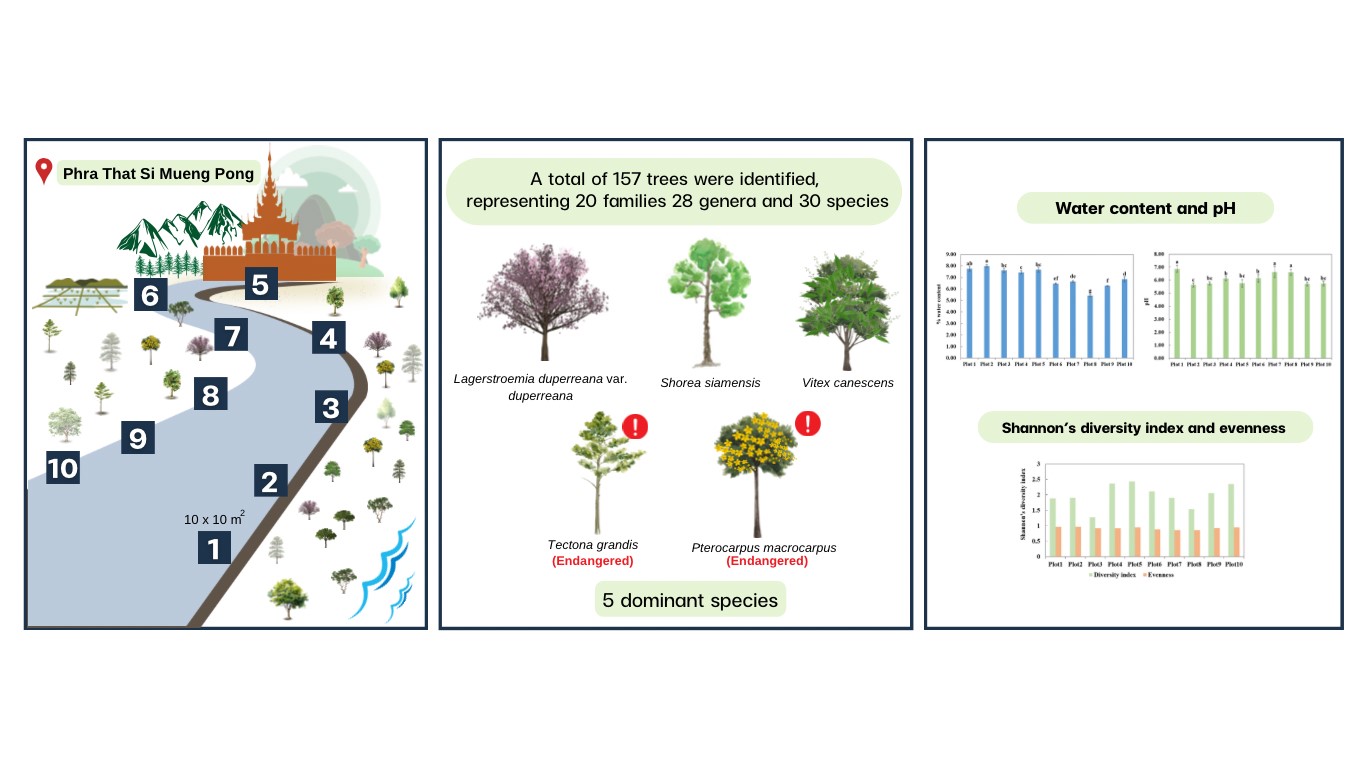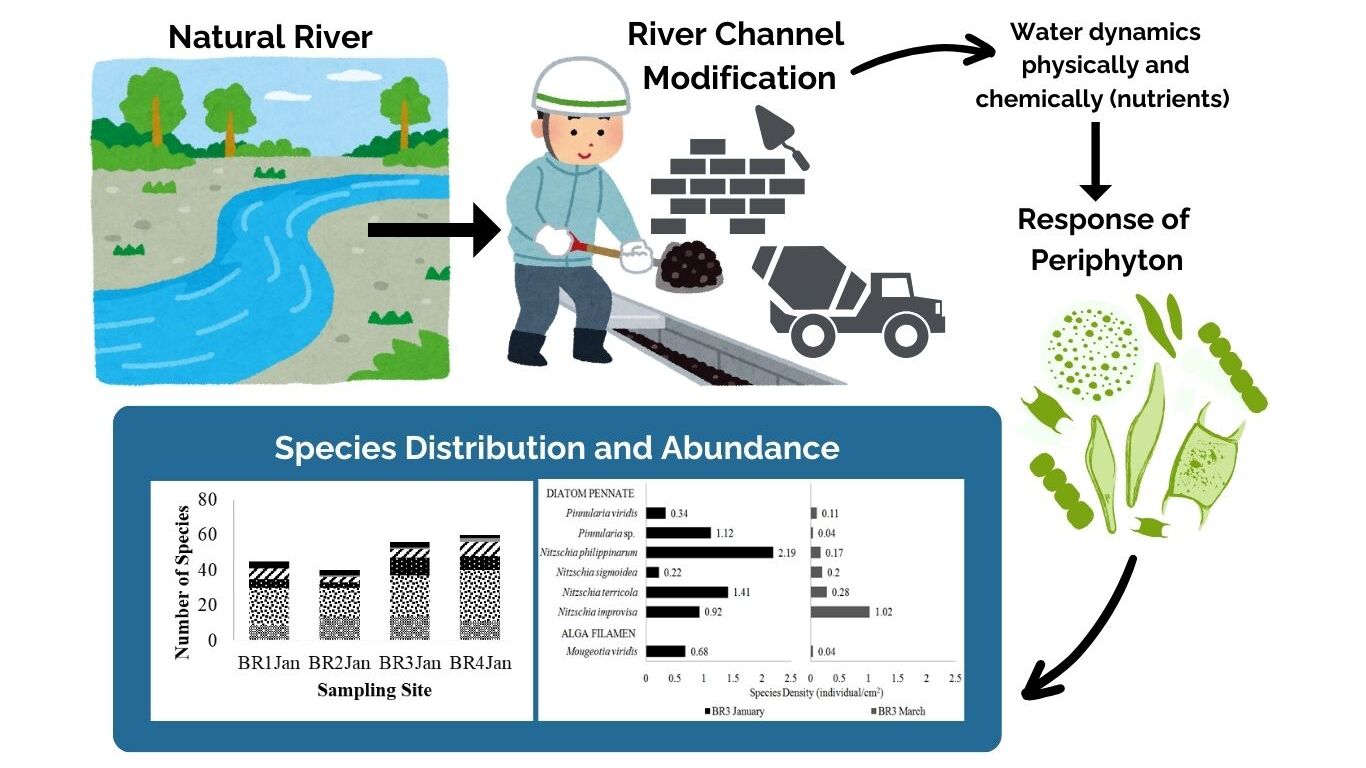BRYOPHYTE DIVERSITY AND ATMOSPHERIC POLLUTION IN A RESIDENTIAL AREA AND AN INDUSTRIAL URBAN FOREST IN JAKARTA, INDONESIA
Downloads
Bryophytes are nonvascular plants that have simple structures that are sensitive to environmental changes, and they can, therefore be used as indicators of air quality. The presence of bryophytes in disturbed urban ecosystems, such as residential and industrial areas, indicates that their structures have adapted to survive in such areas. The objective of this study was to compare the bryophyte diversity and air quality indices between a residential area and an industrial area in Jakarta. The research was conducted in the Bona Indah residential area in South Jakarta and the Jakarta Industrial Estate Pulogadung (JEIP) urban forest. Sampling was carried out using the transect method in the residential area and the quadratic method in the urban forest on three different substrates, namely rocks or concrete, soil and tree trunks. The percentage of the epiphytic bryophyte cover was measured using a 10 × 10 cm subplot. Voucher specimens were stored at the Herbarium UI DEP and Herbarium IPB. Twenty-one species of moss and three species of liverwort were found in the two locations. Bryophytes were found on all the substrates in the residential area, but in the urban forest, they were found only on tree trunks and rock/cement substrates. Based on the Shannon–Wiener Index, although both locations had moderate bryophyte diversity, the residential area’s bryophyte diversity was higher than that of the urban forest. The index of atmospheric purity in the residential area was 4.3, indicating a high level of pollution, and it was 0.3 in the urban forest, showing that it was also very polluted.
Downloads
Andayaningsih D, Chikmawati T, Sulistijorini. 2013. Keanekaragaman tumbuhan paku terestrial di hutan kota DKI Jakarta. [Terestrial ferns diversity in urban forest DKI Jakarta]. Ber Biol 12(3): 297-365.
Bahuguna YM, Gairola SU, Semwal DP, Uniyal PL, Bhat AB. 2013. Bryophyte and ecosystem. In: Gupta, RK, Kumar K, editors. Biodiversity of lower plants. International Publishing House, New Delhi, India. P. 279-96.
Da Costa DP. 2015. Diversity and conservation of Pottiaceae (Pottiales) in the Atlantic Rainforest. Acta Bot Brasilica 29(3): 354-74. DOI: https://doi.org/10.1590/0102-33062015abb0012
Dymitrova L. 2009. Epiphytic lichens and bryophytes as indicators of air pollution in Kyiv City (Ukraine). Foloa Crypotog Estonica Fasc 46: 33-44.
Ezukanma IO, Tessler M, Salaam AM, Kanayo S, Chukwuka & Ogunniran AJ. 2019. Epiphytic bryophytes of urban agroforests in Ibadan, Southwest Nigeria. J Bryo [Internet]. [cited 2023 Jan 1]; 41(4): 341-9. Available from: https://www.tandfonline.com/loi/yjbr20, doi: 10.1080/03736687.2019.1611250. DOI: https://doi.org/10.1080/03736687.2019.1611250
Fastanti FS, Wulansari TRI. 2021. The dynamics of bryophytes species diversity in the Lowland ecosystems, Cibinong Science Center Botanical Garden. Jurnal Ilmiah Biologi Eksperimen dan Keanekaragaman Hayati [Internet]. [cited 2022 Dec 20]; 8(2): 8-17. Available from http://jurnalbiologi.fmipa.unila.ac.id/index.php/ jbekh DOI: https://doi.org/10.23960/jbekh.v8i2.194
Fastanti FSF, Fitmawati F, Sofiyanti N. 2013. Mosses in several type of vegetation in n the Giam Siak Kecil-Bukit Batu Biosphere Reserve Area, Riau Province. [Undergraduate Thesis]. Faculty of Mathematics and Natural Science, Universitas Riau Pekanbaru.
Floyed A, Gibson M. 2012. Bryophytes of urban industrial streetscapes in Victoria, Austria. Vic Nat 129(6): 203-14.
Frahm J-P. 2003. Manual of tropical bryology. Trop Bryol 23: 39-48. DOI: https://doi.org/10.11646/bde.23.1.1
Freedman B. 2018. Environmental sciences. Dalhousie University.
Fudali E, Żoknierz, L. 2019. Epiphytic bryophytes in urban forest of Wroclaw (SW Poland). Biodiv Res Conserv [Internet]. [cited 2022 Nov 11]; 53: 73-83. Available from https://sciendo.com/article/ 10.2478/biorc-2019-0007 doi: 10.2478/biorc-2019-0007 DOI: https://doi.org/10.2478/biorc-2019-0005
Giordano S, Sorbo S, Adamo P, Basile A, Spagnuolo V, Cobianchi RC. 2004. Biodiversity and trace element content of epiphytic bryophytes in urbanand extraurban sites of southern Italy. Plant Ecol 170: 1-14. DOI: https://doi.org/10.1023/B:VEGE.0000019025.36121.5d
Godovićová K, Mišíková K, Hrabová D. 2020. Bryophyte flora of selected historical parks and gardens of Slovakia. Biol [Internet]. [cited 2022 Nov 11]; 75:1127-34. Available from https://link.springer.com/article/10.2478/s11756-020-00462-6 https://doi.org/10.2478/s11756-020-00462-6 DOI: https://doi.org/10.2478/s11756-020-00462-6
Govindapyari H, Leleeka M, Nivedita M, Uniyal PL. 2010. Bryophytes: Indicators and monitoring agents of pollution. NeBio 1: 35-41.
He X, He KS, Hyvönen J. 2016. Will bryophyte survive in the warm world? Perspect Plant Ecol Evol Syst [Internet]. [cited 2022 Nov 11]; 19:49-60. Available from https://www.sciencedirect.com/science/ article/abs/pii/S1433831916300117?via%3Dihub doi: 10.1016/j.ppees.2016.02.005 DOI: https://doi.org/10.1016/j.ppees.2016.02.005
Kanawade SM, Hamigi AD, Gaikwad RW. 2010. Ecological effect of pollution. Int J Chem Eng Appl 1(4): 332-5. DOI: https://doi.org/10.7763/IJCEA.2010.V1.57
Kou, J, Feng C, Bai XL, Chen H. 2014. Morphology and taxonomy of leaf papillae and mammilae in Pottiaceae of China. J Syst Evol 52(4): 521-32. DOI: https://doi.org/10.1111/jse.12074
Kürschner, H. 2004. Life strategies and adaptation in bryophytes from the Near and Middle East. Turk J Bot 28: 73-84.
Le Blanc F. 1971. Possibilities and methods for mapping air pollution on the basis of lichen sensitivity. Mitteilungen der forstlichen Bundes-Versuchsanstalt Wien 92: 103-26
Lestari P, Arrohman MK, Damayanti S, Klimont Z. 2022. Emissions and spatial distribution of air pollutants from anthropogenic sources in Jakarta. Atmos Pollut Res [Internet]. [cited 2022 October 10]; 13: 101521. Available from: doi: 10.1016/ j.apr.2022.101521 DOI: https://doi.org/10.1016/j.apr.2022.101521
Jiang Y, Shaaban M, Zhang X, Hu R, Zhao J, Fan M, Wu Y. 2020. Urban atmospheric environment quality assessment by naturally growing bryophytes in Central China. Int J Environ Res Public Health [Internet]. [cited 2022 Nov 11]. 17(4537): 1-14. Available from https://www.mdpi.com/1660-4601/17/12/4537 doi: 10.3390/ijerph17124537 DOI: https://doi.org/10.3390/ijerph17124537
Lubis SH, Arifin HS, Samsoedin I. 2013. Analisis cadangan karbon pohon pada lanskap hutan kota di DKI Jakarta [Tree carbon stock analysis of urban forest landscape in DKI Jakarta]. J Penelit Sos Ekon Kehutan 10(1): 1-20. DOI: https://doi.org/10.20886/jpsek.2013.10.1.1-20
Mukhia S, Mandal P, Singh DK, Singh D. 2019. The abundance of epiphytic liverworts on the bark of Cryptomeria japonica in relation to different physical and biochemical attributes, found in Senchal Wildlife Sanctuary, Darjeeling, Eastern Himalaya. BMC Ecol [Internet]. [cited 2023 Jan 2]; 19:37. Available from https://bmcecol.biomedcentral.com/articles/10.1186/s12898-019-0253-9 doi: 10.1186/s12898-019-0253-9 DOI: https://doi.org/10.1186/s12898-019-0253-9
Oishi Y, Hiura T. 2017. Bryophyte as bioindicators of the atmospheric environment in urban-forest landscape. Landsc Urban Plan [Internet]. [cited 2022 Nov 11]; 167: 348-55. Available from https://www.sciencedirect.com/science/article/ abs/pii/S016920461730172X doi: 10.1016/ j.landurbplan.2017.07.010 DOI: https://doi.org/10.1016/j.landurbplan.2017.07.010
Oishi Y. 2019. Urban heat island effects on moss gardens in Kyoto, Japan. Landsc Ecol Eng [Internet]. [cited 2022 Nov 10]; 15:177–184. Available from https://link.springer.com/article/10.1007/s11355-018-0356-z doi: 10.1007/s11355-018-0356-z DOI: https://doi.org/10.1007/s11355-018-0356-z
Permatasari PA, Amalo LF, Wijayanto AK. 2019. Comparison of urban heat island effect in Jakarta and Surabaya, Indonesia. In Proc of SPIE 2019. Sixth International Symposium on LAPAN-IPB Satellite. P. 1137209-6. DOI: https://doi.org/10.1117/12.2541581
Pescott OL, Simkin JM, August TA, Randle Z, Dore AJD, Botham MSB. 2015. Air pollution and its effects on lichens, bryophytes, and lichen-feeding Lepidoptera: review and evidence from biological records. Biol J Linn Soc 115: 611-35. DOI: https://doi.org/10.1111/bij.12541
Printanakul N, Jampeetong A. 2020. A preliminary study on morphological variations from wet and dry microhabitats of hyophila involuta (Pottiaceae, Bryophyta): A case study from Chiang Mai Province, Northern Thailand. Chiang Mai Univ J Nat Sci [Internet]. [cited 2022 Dec 1]; 20(1): 1-16. Available from https://cmuj.cmu.ac.th/ cmu_journal/cmu_journal.php DOI: https://doi.org/10.12982/CMUJNS.2021.020
Proctol, MCF, Tuba Z. 2002. Poikilohydry and homoihydry: Antithesis or spectrum of possibilities? New Phytol 156(3): 327-49. DOI: https://doi.org/10.1046/j.1469-8137.2002.00526.x
Putra CD, Ramadhani A, Fatimah E. 2021. Increasing urban heat island area in Jakarta and its relation to land use changes. In IOP Conf Series: Earth and Environmental Science. The 5th International Seminar on Sustainable Urban Development. P. 012002. DOI: https://doi.org/10.1088/1755-1315/737/1/012002
Putrika A, Nisyawati, Ariyanti NS. 2017. Keanekaragaman lumut epifit di hutan kota dan jalan utama kampus Universitas Indonesia. [Diversity of ephifit bryophytes in the urban forest and main street margin of Indonesia University campus]. Biosite 3(3): 25-38.
Uttara S, Bhuvandas N, Aggarwal V. 2012. Impacts of urbanization on environment. IJREAS 2(2): 1637-45.
Spitale D, Mair P, Nascimbene J. 2020. Patterns of bryophyte life-forms are predictable across land cover types. Ecol Indic [Internet]. [cited 2022 Nov 11]; 109:1-7. Available from https://www.sciencedirect.com/science/article/ pii/S1470160X19307939?via%3Dihub doi: 10.1016/j.ecolind.2019.105799 DOI: https://doi.org/10.1016/j.ecolind.2019.105799
Syihabuddin A, Darmadi A, Waryono T. 2020. Analisis fungsi jasa bio-ekologis hutan kota kawasan industri. [Analysis of the function of bio-ecological services for industrial area urban forest]. Jurnal Bumi Lestari [Internet]. [cited 2023 Jan 2]; 20(1):1-7. Available from https://ojs.unud.ac.id/ index.php/blje/article/view/71759 doi: 10.24843/ blje.2020.v20.i01.p01 DOI: https://doi.org/10.24843/blje.2020.v20.i01.p01
Szlavecs K, Warren P, Pickett P. 2011. Biodiversity on the urban landscape. In: Cincotta RP, LJ Gorenflo, editors. Human population: Its influences on biological diversity. Berlin: Springer-Verlag. P. 75-101. DOI: https://doi.org/10.1007/978-3-642-16707-2_6
Szűcs P, Pénzes-Kónya E, Hofmann T. 2017. The bryophyte flora of the village of Almásfüzitő, a former industrial settlement in NW-Hungary. Cryptogam Bryol [Internet]. [cited 2022 Dec 1]; 38(2): 153-70. Available from https://doi.org/10.7872/cryb/v38.iss2.2017.153 DOI: https://doi.org/10.7872/cryb/v38.iss2.2017.153
Vanderpoorten A, Goffinet B. 2009. Introduction to bryophytes. Cambridge: Cambridge University Press. DOI: https://doi.org/10.1017/CBO9780511626838
Vitt DH, Crandall-Stotler B, Wood A. 2014. Bryophyte: Survival in a dry world through tolerance and avoidance. In: Rajakaruna N, Boyd R, Harris T, editors. Plant ecology and evolution in harsh environments. Nova Publishers. P. 267-95.
Zander, H. 1993. Genera of the pottiaceae: Mosses of harsh environments. Bull Buffalo Soc Nat Sci.
Zhao D, Zhang C, Sun Z, Wang C, Hao Z, Sun B, Zuo Q, Sun R, Jin J, Wang H. 2021. Urban orchards provide a suitable habitat for epiphytic bryophytes. For Ecol Manag [Internet]. [cited 2022 October 10]; 483:11. Available from: https://doi.org/10.1016/ j.foreco.2020.118767 DOI: https://doi.org/10.1016/j.foreco.2020.118767
Copyright (c) 2023 Afiatry Putrika, Andi Salamah

This work is licensed under a Creative Commons Attribution-NonCommercial-NoDerivatives 4.0 International License.
Authors who publish with this journal agree with the following terms:
- Authors retain copyright and grant the journal right of first publication, with the work 1 year after publication simultaneously licensed under a Creative Commons attribution-noncommerical-noderivates 4.0 International License that allows others to share, copy and redistribute the work in any medium or format, but only where the use is for non-commercial purposes and an acknowledgement of the work's authorship and initial publication in this journal is mentioned.
- Authors are able to enter into separate, additional contractual arrangements for the non-exclusive distribution of the journal's published version of the work (e.g., post it to an institutional repository or publish it in a book), with an acknowledgement of its initial publication in this journal.
- Authors are permitted and encouraged to post their work online (e.g., in institutional repositories or on their website) prior to and during the submission process, as it can lead to productive exchanges, as well as earlier and greater citation of published work (See The Effect of Open Access).





























